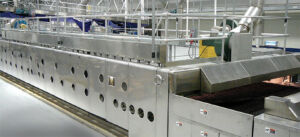
In the industrial baking of any type of bread, and a multitude of other product ranges, tunnel ovens are the giants of large-volume, continuous baking, for which efficiency is a must.
Innovation in improving the process efficiency of tunnel ovens is the result of a comprehensive investigation of every equipment part, product requirement and manufacturer needs. Savings can amount to values that are specific to every facility and its methods; however, every parameter optimization can translate into significant gains.

Energy efficiency: the THERMADOR
The efficiency of the THERMADOR oven by WP Bakerygroup is given by the length configuration of the heating gas zones, up to four, and their respective channels transferring the heat to the baking chamber. It requires lower heating gas temperatures for baking compared to its predecessors, which is made possible by increasing the mass-flow throughout the oven by 20-25%. This helps obtain a lower temperature difference between the entrance and the outlet of the radiators, independent of the length of the heating gas channels. It also enables a very good distribution of the temperature and of the heat transfer itself, with minimal energy loss released into the environment.
The lower temperature difference achieved is also combined with improved isolation: the entire oven is isolated manually with mineral wool. “Our specialists are able to insulate the THERMADOR ovens without compressing the mineral wool too much, to preserve heat in the oven. The goal is to keep the best isolation material in it: air,” explains Siegfried Lauer – head of overall project planning, WP Industrial Bakery Technology (WP IB). The isolation is done manually, so people can fill up spaces that are not normally easily accessible. “This is the traditional and, still, the best way to do this,” adds Ulrich Speck – head of oven design department at WP IB.
Airflow control
The traditional setup of the THERMADOR comprises a closed cyclotherm heating gas circulation system, heating products indirectly, by radiation. With convection systems gaining ground, other oven variants incorporate either active solutions, in which heat is transferred into the baking chamber, or with revolving air. In the latter version, an
agitating unit revolves the air, with a Duo or a Quattro fan setup.
The calculation of the airflow is done based on the 3D design of the oven and a mathematical flow simulation software that determines the correct gaps for optimal airflow in the oven, over the full width of the oven. In the simulation, this program also includes temperature losses and differences in the baking chamber, based on real-life readings. WP Bakerygroup will select and input the data to obtain accurate simulations that take into consideration all relevant parameters.
In the length of a zone, which can be 4.5m, 6m, or 7.5m, the Duo unit has two fans, placed diagonally to achieve airflow and circulation internally in its baking chamber. “Air can also go through a channel system over the fan and return into the baking chamber, for a convection effect,” Lauer details. The Quatro system doubles the internal convection air capacity with four such fans, each placed in opposition to the others, 2-2.5m apart. Every fan is revolving air on half of the oven’s width, which is why for wider ovens, WP Bakerygroup recommends the Quattro setup. The result is an optimized temperature transfer to the product, which reduces baking time, as the Quattro System gives more turbulence in the oven. This is a particularly useful technology concept, given that the trend is for ovens to become even wider in the future. This air revolution in the baking chamber gives a better heat transfer as well.
“Duo and Quattro are particularly efficient when there is a lot of mass material (i.e., steel) involved in production, for example for toast bread, thanks to the very efficient heat transfer to the material supporting the dough,” Lauer highlights. The latest developments in these models are new air guides that improve air distribution and movement. “These helped achieve very good vertical convection in the Thermador,” Speck also says.


